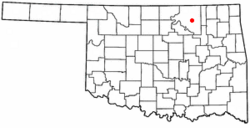Wynona, Oklahoma facts for kids
Quick facts for kids
Wynona, Oklahoma
|
|
|---|---|

Location of Wynona, Oklahoma
|
|
| Country | United States |
| State | Oklahoma |
| County | Osage |
| Area | |
| • Total | 0.55 sq mi (1.42 km2) |
| • Land | 0.55 sq mi (1.42 km2) |
| • Water | 0.00 sq mi (0.00 km2) |
| Elevation | 902 ft (275 m) |
| Population
(2020)
|
|
| • Total | 370 |
| • Density | 673.95/sq mi (260.16/km2) |
| Time zone | UTC-6 (Central (CST)) |
| • Summer (DST) | UTC-5 (CDT) |
| ZIP code |
74084
|
| Area code(s) | 539/918 |
| FIPS code | 40-82450 |
| GNIS feature ID | 2413516 |
Wynona is a small town located in the middle of Osage County, Oklahoma, in the United States. It was started in 1903 by a local rancher named Antoine Rogers, who was part Osage and part Cherokee. In 2020, about 370 people lived there. The population was 437 at the 2010 census, which was a decrease from 531 people in 2000.
Contents
History of Wynona
Early Settlement and Growth
Antoine Rogers, an Osage-Cherokee rancher, first settled in the Wynona area in 1871. This was after the Osage tribe moved from Kansas to what was then called Indian Territory by the U.S. Government.
In 1903, the Missouri, Kansas and Texas Railway (also known as the Katy railroad) built a train line across Rogers's land. A store was built next to the tracks, and this is seen as the start of Wynona. The town quickly became a place where cattle were shipped out.
The Osage Townsite Company began to develop the town in 1909. By the end of that year, the population grew from 20 to more than 150 residents. The first local newspaper, a weekly called the Wynona Enterprise, started in August 1909.
Oil Boom and Decline
Oil was found near Wynona in 1914. This led to the creation of the Wynona Oil and Gas Company. Many new residents moved to the town to work in the oil industry. Wynona's population grew to 2,749 people by the 1920 census.
Wynona also remained important for its farming and ranching. Ranchers started raising hogs, poultry, and dairy products. However, the town did not get electricity or paved streets. This caused some business owners to move away.
The oil boom in Osage County ended, and the Great Depression began. These events caused the town's population to drop sharply. It fell to 1,171 in 1930 and to 652 in 1960. The Katy railroad stopped using its train line in 1977.
1946 Tornado Event
On March 22, 1946, a very strong tornado hit Wynona. Experts believe it was an F4 tornado on the Fujita scale. The tornado destroyed a power plant and 15 homes. It also damaged ten other homes. The tornado traveled about 3 miles (4.8 km) and was 800 yards (730 m) wide. It even carried a 500-pound (227 kg) piece of machinery for half a mile (0.8 km). The damage was estimated to be $150,000 in 1946.
Geography
According to the United States Census Bureau, the town of Wynona covers a total area of 0.5 square miles (1.42 square kilometers). All of this area is land.
Population Information
| Historical population | |||
|---|---|---|---|
| Census | Pop. | %± | |
| 1920 | 2,749 | — | |
| 1930 | 1,171 | −57.4% | |
| 1940 | 810 | −30.8% | |
| 1950 | 678 | −16.3% | |
| 1960 | 652 | −3.8% | |
| 1970 | 547 | −16.1% | |
| 1980 | 780 | 42.6% | |
| 1990 | 531 | −31.9% | |
| 2000 | 531 | 0.0% | |
| 2010 | 437 | −17.7% | |
| 2020 | 370 | −15.3% | |
| U.S. Decennial Census | |||
As of the census in 2000, there were 531 people living in Wynona. These people lived in 221 households, and 150 of these were families. The town had about 982.5 people per square mile (379.3 people per square kilometer). There were 246 housing units, with an average of 455.2 per square mile (175.8 per square kilometer).
In 2000, about 29.4% of households had children under 18 living with them. About 52.9% were married couples living together. The average household had 2.40 people, and the average family had 2.96 people.
The population was spread out by age. About 25.0% were under 18 years old. About 14.3% were 65 years or older. The average age was 36 years.
Education
Wynona is part of the Wynona Public Schools system.
See also
 In Spanish: Wynona (Oklahoma) para niños
In Spanish: Wynona (Oklahoma) para niños

